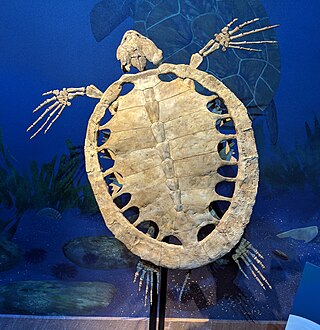This is a list of fossiliferous stratigraphic units in Angola .
This is a list of fossiliferous stratigraphic units in Angola .
Itombe formation was considered Turonian in age, but new data suggests to be Coniacian. [9]

Euclastes is an extinct genus of sea turtles that survived the Cretaceous–Paleogene mass extinction. The genus was first named by Edward Drinker Cope in 1867, and contains three species. E. hutchisoni, was named in 2003 but has since been reassigned to the genus Pacifichelys, while E. coahuilaensis named in 2009 was reassigned as Mexichelys coahuilaensis in 2010.
The Tiourarén Formation is a geological formation in the Agadez Region of Niger whose strata were originally thought to be Early Cretaceous. However, re-interpretation of the sediments showed that they are probably Middle Jurassic (Bathonian) in age. It is the uppermost unit of the Irhazer Group. Dinosaur remains are among the fossils that have been recovered from the formation.
The In Beceten Formation, also Beceten or Ibecten is a Coniacian to Santonian geologic formation in the Iullemmeden Basin of Niger. Dinosaur remains are among the fossils that have been recovered from the formation, although none have yet been referred to a specific genus. The lithology primarily consists of clays, fine limestones and sandy clays.
The Irhazer Shale or Irhazer II Formation is a Middle Jurassic geologic formation of the Irhazer Group in the Agadez Region of Niger. Fossil ornithopod tracks have been reported from the formation. The dinosaur Spinophorosaurus is known from the formation.

Angolachelys is an extinct genus of African eucryptodiran turtle which existed in Angola during the Turonian stage of the Late Cretaceous. The type species is Angolachelys mbaxi. The type MGUAN-PA includes skull, jaw, and postcranial fragments found in the Tadi Beds of the Itombe Formation.

Angolatitan is a genus of titanosauriform sauropod dinosaur from the Upper Cretaceous. It is also the first non-avian dinosaur discovered in Angola. The genus contains a single species, Angolatitan adamastor, known from a partial right forelimb. Angolatitan was a relict form of its time; it was a Late Cretaceous basal titanosauriform, when more derived titanosaurs were far more common.

The geology of Angola includes large areas of Precambrian age rocks. The west of the country is characterized by meta-sedimentary rocks of Proterozoic age including tillites assigned to the Bembe System. Overlying these are a thick pile of limestones and other marine sediments laid down during the Mesozoic and Cenozoic eras. Amidst the Proterozoic sequence are areas of crystalline basement dating from the Archaean. More Archaean basement rocks form the Kasai Craton in northeastern Angola. In the north, within the Cassanje Graben are clastic sediments and volcanic rocks of the Karoo Supergroup. Kimberlites and carbonatites resulting from magmatic activity during the Karoo period are found along a northeast-southwest line through the country. Continental sediments of the Kalahari Group are widespread in eastern Angola.
The Bentiaba is a river in southern Angola. Its mouth is at the Atlantic Ocean near the commune of Bentiaba in Namibe Province.
The Itombe Formation is a geological formation of the Kwanza Basin in Angola dated to the Coniacian stage of the Late Cretaceous. The environment of deposition is shallow marine. Reptile fossils have been recovered from the Tadi beds locality within the formation, including the dinosaur Angolatitan, the mosasaurs Angolasaurus and Mosasaurus iembeensis and the turtle Angolachelys.The Itombe formation was formerly considered Turonian in age, but new data suggests to be Coniacian.
The Mocuio Formation is a Late Cretaceous sedimentary rock formation found in southern Angola. It extends from the latest Campanian to the Early Maastrichtian. Many vertebrate fossils have been collected from the formation.